Adipose tissue-specific inhibition of hypoxia-inducible factor 1{alpha} induces obesity and glucose intolerance by impeding energy expenditure in mice
- PMID: 20716529
- PMCID: PMC2963410
- DOI: 10.1074/jbc.M110.135509
Adipose tissue-specific inhibition of hypoxia-inducible factor 1{alpha} induces obesity and glucose intolerance by impeding energy expenditure in mice
Abstract
Hypoxia in adipose tissue has been postulated as a possible contributor to obesity-related chronic inflammation, insulin resistance, and metabolic dysfunction. HIF1α (hypoxia-inducible factor 1α), a master signal mediator of hypoxia response, is elevated in obese adipose tissue. However, the role of HIF1α in obesity-related pathologies remains to be determined. Here we show that transgenic mice with adipose tissue-selective expression of a dominant negative version of HIF1α developed more severe obesity and were more susceptible to high fat diet-induced glucose intolerance and insulin resistance compared with their wild type littermates. Obesity in the transgenic mice was attributed to impaired energy expenditure and reduced thermogenesis. Histological examination of interscapular brown adipose tissue (BAT) in the transgenic mice demonstrated a markedly increased size of lipid droplets and decreased mitochondrial density in adipocytes, a phenotype similar to that in white adipose tissue. These changes in BAT of the transgenic mice were accompanied by decreased mitochondrial biogenesis and reduced expression of key thermogenic genes. In the transgenic mice, angiogenesis in BAT was decreased but was little affected in white adipose tissue. These findings support an indispensable role of HIF1α in maintaining the thermogenic functions of BAT, possibly through promoting angiogenesis and mitochondrial biogenesis in this tissue.
Figures
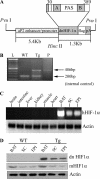
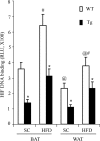

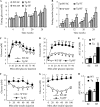

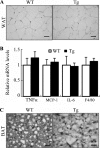
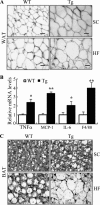

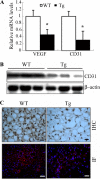
Similar articles
-
Adipocyte-specific Hypoxia-inducible gene 2 promotes fat deposition and diet-induced insulin resistance.Mol Metab. 2016 Sep 28;5(12):1149-1161. doi: 10.1016/j.molmet.2016.09.009. eCollection 2016 Dec. Mol Metab. 2016. PMID: 27900258 Free PMC article.
-
Adipose HIF-1α causes obesity by suppressing brown adipose tissue thermogenesis.J Mol Med (Berl). 2017 Mar;95(3):287-297. doi: 10.1007/s00109-016-1480-6. Epub 2016 Oct 14. J Mol Med (Berl). 2017. PMID: 27738746 Free PMC article.
-
Overexpression of Adiponectin Receptor 1 Inhibits Brown and Beige Adipose Tissue Activity in Mice.Int J Mol Sci. 2021 Jan 18;22(2):906. doi: 10.3390/ijms22020906. Int J Mol Sci. 2021. PMID: 33477525 Free PMC article.
-
Origins and early development of the concept that brown adipose tissue thermogenesis is linked to energy balance and obesity.Biochimie. 2017 Mar;134:62-70. doi: 10.1016/j.biochi.2016.09.007. Epub 2016 Sep 10. Biochimie. 2017. PMID: 27621146 Review.
-
Energy dissipation in brown adipose tissue: from mice to men.Mol Cell Endocrinol. 2013 Oct 15;379(1-2):43-50. doi: 10.1016/j.mce.2013.04.017. Epub 2013 Apr 28. Mol Cell Endocrinol. 2013. PMID: 23632102 Review.
Cited by
-
In vivo delivery of cell-permeable antisense hypoxia-inducible factor 1α oligonucleotide to adipose tissue reduces adiposity in obese mice.J Control Release. 2012 Jul 10;161(1):1-9. doi: 10.1016/j.jconrel.2012.04.026. Epub 2012 Apr 23. J Control Release. 2012. PMID: 22546680 Free PMC article.
-
Negative regulation of human growth hormone gene expression by insulin is dependent on hypoxia-inducible factor binding in primary non-tumor pituitary cells.J Biol Chem. 2012 Sep 28;287(40):33282-92. doi: 10.1074/jbc.M112.380949. Epub 2012 Jul 25. J Biol Chem. 2012. PMID: 22833680 Free PMC article.
-
Adipokines: a link between obesity and cardiovascular disease.J Cardiol. 2014 Apr;63(4):250-9. doi: 10.1016/j.jjcc.2013.11.006. Epub 2013 Dec 16. J Cardiol. 2014. PMID: 24355497 Free PMC article. Review.
-
Heritable genetic variants in key cancer genes link cancer risk with anthropometric traits.J Med Genet. 2021 Jun;58(6):392-399. doi: 10.1136/jmedgenet-2019-106799. Epub 2020 Jun 26. J Med Genet. 2021. PMID: 32591342 Free PMC article.
-
Selective overexpression of human SIRT1 in adipose tissue enhances energy homeostasis and prevents the deterioration of insulin sensitivity with ageing in mice.Am J Transl Res. 2013 May 24;5(4):412-26. Print 2013. Am J Transl Res. 2013. PMID: 23724165 Free PMC article.
References
Publication types
MeSH terms
Substances
LinkOut - more resources
Full Text Sources
Medical

